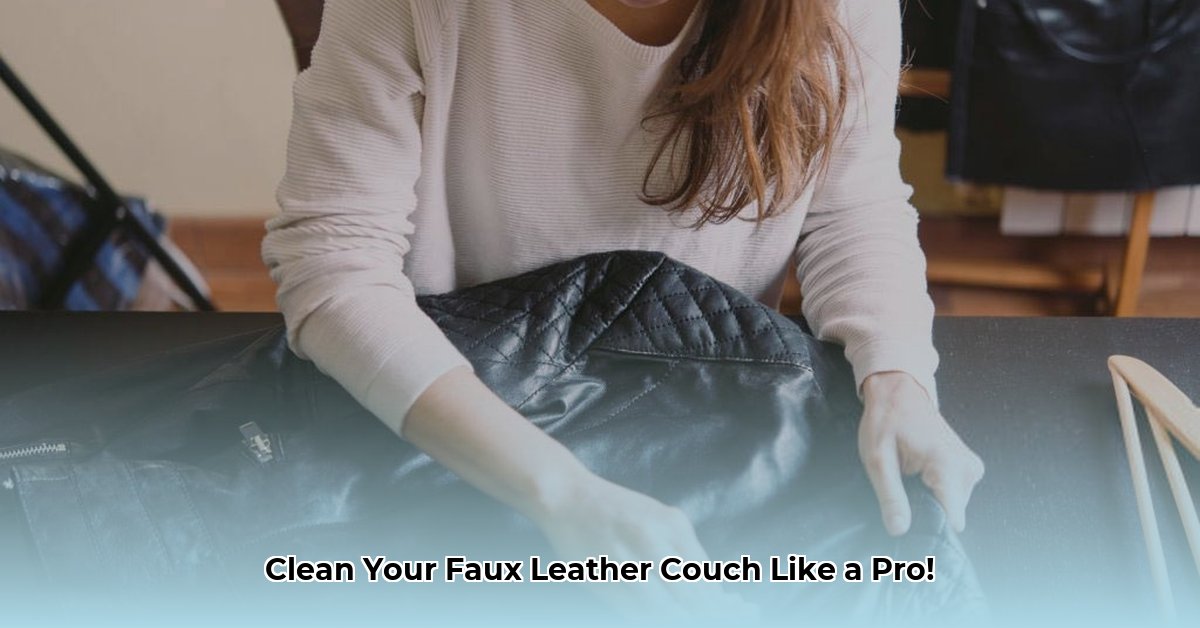Keeping your pleather couch clean not only keeps it looking its best but also prolongs its life. This comprehensive guide offers easy-to-follow instructions, helpful tips, and troubleshooting advice for maintaining your faux leather furniture.
Refreshing Your Faux Leather: Simple Cleaning Techniques
Regular cleaning prevents dirt buildup and keeps your pleather looking vibrant.
Dusting and Vacuuming: The Dynamic Duo
- Dusting: Gently wipe down your couch with a soft, dry cloth to remove loose dust and debris.
- Vacuuming: Use a vacuum with a soft brush attachment to remove stubborn dirt and crumbs from crevices and seams. Don’t forget to vacuum under the cushions!
The Weekly Wipe Down: A Refreshing Routine
- Mix Your Solution: Combine warm water and a few drops of mild dish soap in a spray bottle. A little soap goes a long way.
- Dampen (Don’t Soak): Lightly mist a clean microfiber cloth with the solution. Too much moisture can damage pleather.
- Wipe and Dry: Gently wipe the entire surface in small sections, immediately drying each section with a clean, dry cloth to prevent water spots.
Deep Cleaning: Tackling Stubborn Stains and Grime
Life happens, and spills are inevitable. Here’s how to handle those tougher cleaning challenges:
Stain Removal Strategies
- Food and Drink Stains: Blot (don’t rub!) the stain with a cloth dampened with a solution of equal parts water and white vinegar. For stubborn stains, a drop or two of mild dish soap can be added to the solution.
- Ink Stains: Carefully dab the stain with a cotton ball soaked in rubbing alcohol. Avoid rubbing, as this can spread the ink.
- Oil or Grease Stains: Apply a paste of baking soda and water to the stain. Let it sit for a few hours or overnight, then gently wipe away with a damp cloth. Baking soda is known for its absorbent properties.
Vinegar Deep Dive (For Stubborn Stains)
Apply the vinegar solution to the stain and let it sit for several minutes before blotting with a clean cloth. Repeat as necessary. Some studies suggest vinegar’s acidity may affect certain pleather types over time, so use with caution.
Isopropyl Alcohol (A Precise Tool)
Isopropyl alcohol (70% or higher) can be effective on stubborn stains. Apply a small amount to a cotton ball and dab gently. Always test on a hidden area first, as alcohol can affect certain finishes.
Maintaining Your Pleather: Proactive Care Tips
Preventing problems is always easier than fixing them. These tips will help keep your pleather couch looking its best:
Regular Dusting: Your First Line of Defense
Make dusting your couch a weekly habit to prevent dirt buildup and maintain its shine.
Protective Covers: Shielding Your Investment
Consider using throws or blankets to protect your couch from spills, scratches, and everyday wear and tear, especially in high-traffic areas.
Conditioning: Nourishing Your Pleather (Optional)
Some experts recommend conditioning pleather every few months to keep it supple and prevent cracking. You can use a specialized faux leather conditioner or even coconut oil (spot test first!). Ongoing research is exploring the long-term impacts of oils on pleather.
Eco-Friendly Cleaning: Gentle on Your Couch and the Planet
Cleaning your pleather couch doesn’t have to harm the environment.
Natural Cleaning Solutions
Vinegar and water, baking soda, and castile soap are all effective, natural cleaning agents that are gentler on the environment. Research is ongoing to discover more eco-friendly cleaning solutions.
Gathering Your Cleaning Supplies: Essential Materials
Having the right tools makes cleaning easier and more effective.
- Mild Dish Soap: Choose a gentle soap, preferably one designed for sensitive skin.
- Warm Water: Use lukewarm water, not too hot or too cold.
- Soft Cloths: Microfiber cloths are ideal, but any soft, non-abrasive cloth (like old t-shirts) will work.
- Spray Bottles: Use spray bottles for even distribution of your cleaning solutions.
- White Vinegar: A natural cleaning powerhouse for stains and odors.
- Baking Soda: A gentle abrasive and odor absorber.
- Rubbing Alcohol (Isopropyl Alcohol): For stubborn stains (use with caution).
- Olive Oil (Optional): May help restore shine (use sparingly, research ongoing).
- Commercial Faux Leather Cleaner (Optional): A convenient pre-made solution (may contain harsher chemicals).
- Vacuum with Soft Brush Attachment: Essential for removing loose dirt and debris before cleaning.
Troubleshooting: Addressing Common Pleather Cleaning Concerns
- Water Rings: Wipe spills immediately. For persistent watermarks, try gently applying heat with a hairdryer on low, held at a safe distance.
- Pet Accidents: Vinegar and water can help neutralize odors and lift stains. Enzymatic cleaners designed for pet stains are another option (test first!).
- Cleaning Don’ts: Avoid harsh chemicals like bleach, ammonia, and abrasive cleaners, which can damage pleather.
Additional Tips for Pleather Care
- Avoid Direct Sunlight: Prolonged exposure to sunlight can fade and crack pleather.
- Use Coasters and Placemats: Protect your couch from spills and rings.
Summary Table: Pleather Cleaning Methods at a Glance
| Cleaning Method | Best For |
|---|---|
| Dusting/Vacuuming | Regular maintenance, crumbs, dust |
| Mild Soap and Water | General cleaning, light soiling |
| Vinegar Solution | Tougher stains, disinfecting |
| Rubbing Alcohol | Ink stains (use with caution) |
| Baking Soda Paste | Oil/grease stains, odor removal |
| Commercial Cleaner | Stubborn stains, deep cleaning (optional) |
| Olive Oil | Restoring shine (optional, test first) |
We hope this comprehensive guide helps you keep your pleather couch looking its best! Share your own cleaning tips and experiences in the comments below.
- NYT Connections Answer: Hedgehog, Pineapple, Cactus The Spiky Things Explained - April 20, 2025
- How to Clean a Wool Carpet: A Comprehensive Guide - April 20, 2025
- How to Clean a Pleather Couch: A Complete Guide - April 20, 2025










